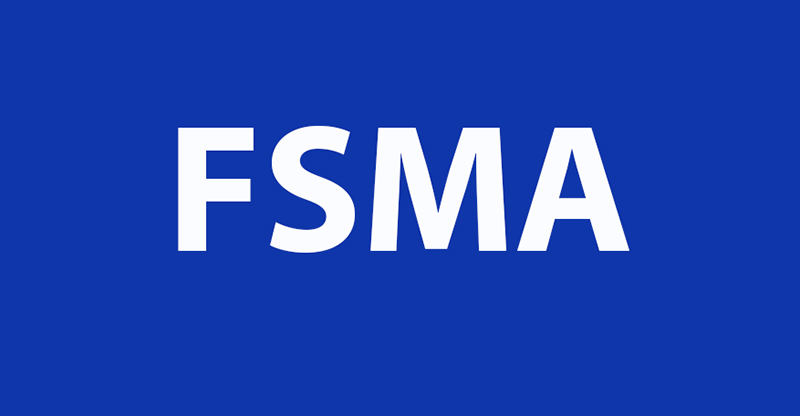The Food Safety Modernization Act (FSMA) requires that food manufacturing and processing companies identify potential hazards within their production systems and then:
- Put in place preventive controls to address those hazards,
- Monitor those preventive controls to ensure their effectiveness &
- Provide documentation proving compliance with these requirements.
There are also requirements for each company to develop and establish its own plan identifying potential food safety hazards and preventive controls to counter them, and to establish the monitoring procedures that will verify the efficacy and reliability of the preventive controls.
Validating, verifying and monitoring the performance of the systems that ensure that only safe food enters the market enables food manufacturers and processors to meet the specific regulatory standards mandated by the countries where they operate and sell. This enables them to avoid product recalls that are costly and that severely damage brand identity. But these processes, in addition to satisfying regulators, also play a valuable part in protecting the companies from potential liability lawsuits, which can often be even more damaging.
The preventive controls most often used to effectively deal with such identified hazards are inspection systems (checkweighers and metal detection, X-ray and machine vision inspection systems) that quickly and efficiently detect non-standard and contaminated products and defective packaging and reject them from production lines before they can enter the marketplace. The performance of these systems must be validated, verified and monitored on an ongoing basis to ensure that they are performing as intended.
These terms–validation, verification and monitoring–are often used interchangeably, creating confusion within organizations and across industries because people interpret and use these terms in different ways. In fact, each term identifies a distinct process that has a clear purpose and role to play at different points throughout the equipment lifecycle. It is important to understand the purpose of each process to make sure that validation, verification and routine performance monitoring tests are performed to comply with regulatory requirements, particularly where the equipment is designated as a Critical Control Point (CCP).
Validation
The fundamental act of “validation,” when applied to inspection systems that are part of a food manufacturing or processing production line, is conducting an objective, data-based confirmation that the system does what it was designed, manufactured and installed to do. The International Featured Standards (IFS) organization defines validation as “confirmation through the provision of objective evidences, that the requirements for the specific intended use or application have been fulfilled.” In 2008, the Codex Alimentarius Commission defined validation as, “Obtaining evidence that a control measure or combination of control measures, if properly implemented, is capable of controlling the hazard to a specified outcome.” An important part of the validation procedure is the production of detailed data that demonstrates to line managers and to regulators that the system is operating as designed.
The manufacturer of each inspection system will validate its performance before delivery, testing it with generic products and packaging similar to what the customer will be producing. But that is only the beginning of the validation process. Onsite, that same system needs to be validated when inspecting the specific products that the production line where it will operate will be processing and/or packaging. This is ideally done at the time the system is originally installed in a production line, and then becomes one element of a complete program of validation, periodic verification and ongoing monitoring that will keep the system operating as intended and ensure that products are adequately and accurately inspected, and that accurate records of those inspections are kept.
It is critical for producers to remember, however, that the original onsite validation relates only to the specific products tested at the time. As new or additional sizes of products are developed and run on the production line, or packaging (including labeling) changes, the system will need to be re-validated for each change.
Verification
Verification is the process of periodically confirming that the inspection equipment continues to be as effective as when it was first validated. The verification process uses standard, established tests to determine whether the inspection system is still under control and continuing to operate as originally demonstrated. This verification process is conducted periodically at regular intervals to provide evidence-based confirmation that the system continues to be effective as specified. Formal performance verification is typically an annual process, to support audit requirements. It should continue throughout the productive life of the system.
Both validation of an installed system and periodic verification of operating systems can be conducted either internally by the end-user, or by the supplier of the equipment. Validation and verification services are often included as part of equipment purchase contracts.
Monitoring
Routine performance monitoring, as distinct from periodic verification, consists of a series of frequent, regular performance checks, during production, completed to determine whether processes are under control and to confirm that there has not been a significant change in the system’s performance level since the last successful test. The monitoring frequency may be as often as every two hours, depending on company standards, industry standards and/or retailer codes of practice.
If the monitoring process finds that a particular device is out of specification, all product that has passed through the production line since the last successful routine performance-monitoring event must be considered suspect and re-inspected.
In many cases, it is line operators that conduct online performance monitoring. However, many of today’s more sophisticated product inspection systems incorporate built-in performance monitoring software that automates this process and alerts operators when deviations occur. This valuable software feature removes any human error factor from the monitoring activity to help ensure that inspection processes are still being performed properly. It also provides documentation that will guide the end-user company’s QA groups in their continuous improvement efforts, and that will also be a valuable asset in the event of an inspection visit from regulators.
Routine performance monitoring can also have a direct impact on the production line’s OEE. Installing a system with built-in condition monitoring capability that automatically detects when the system may need correction and communicates that information directly to line operators reduces the frequency needed for verification testing, maximizing the line’s production uptime.
Reliance on the experts
Finally, food manufacturers and processors should remember that, while they are knowledgeable experts regarding their products, it is their equipment suppliers that are the experts on the capabilities and qualification procedures of their equipment. That expertise makes them the best source of reliable recommendations on questions from the most effective inspection equipment type for specific product needs, where to place that equipment on the production line for optimum results and how to validate, verify and monitor its performance.
Relying on these experts to conduct onsite validation and to advise on conducting periodic verification and ongoing performance monitoring can reduce both the time needed for the original onsite validation time and that needed for verification and ongoing monitoring procedures, increasing productivity.
Companies can also rely on these experts to be knowledgeable on the most current food safety regulations and the technology that affect equipment validation. It is critical for their success that they stay current on those topics, and sharing that knowledge is a valuable part of their service.







